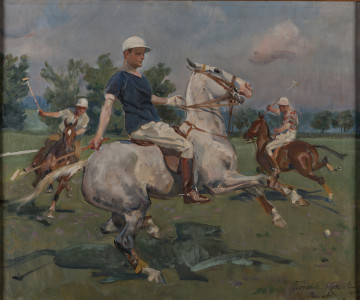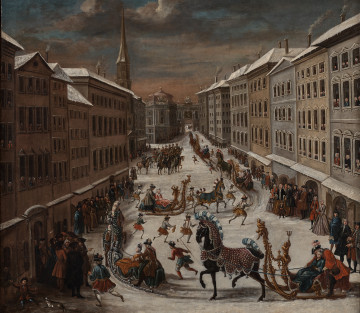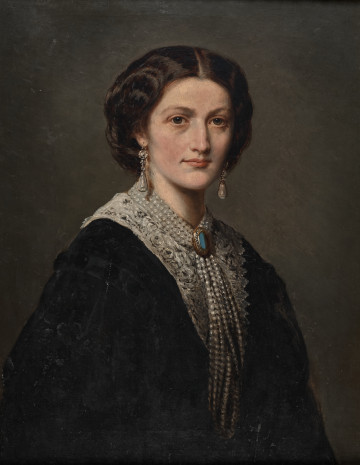
Potocki family playing polo
20th century
Castle Museum in Łańcut
Part of the collection: Painting and drawing
St. John the Baptist The painting from the collection of the museum, presents St. John the Baptist as a child, against the backdrop of a landscape and sky. The colours of the painting are bright, the light falls from the left. The saint is depicted as a boy, a few years in age, transfixed on the Latin cross he is holding in his right hand. The child is almost naked, with just a red cloth swung over its right arm, draped at the rear. In the background, there are trees, painted quite schematically, and a sky in intense, dark blue, covered with white and grey clouds. St. John the Baptist was a hermit, revered as a prophet by Christians and Muslims, and as a saint in Roman Catholic and Eastern Orthodox Christianity. In Roman Catholic Christianity, he is believed to be the ultimate prophet before Christ. He is the patron saint of many cities and orders, he helps those suffering from epilepsy. The painting from Łańcut is a copy of a work by Quercino, or Giovanni Francesco Barbieri (b. February 1591 in Cento, d. December 1666 in Bologna), an Italian painter of the Baroque, called Il Quercino, who was also a graphic artist, fresco painter and art theorist. He came from a rural family, and started learning to paint in 1607 at the workshop of Benedetto Gennati (1563-1610). In 1610 he founded his own drawing and painting workshop in Cento. He was active in Italy, mainly in Cento, Venice, Bologna, Rome, Modena and Piacenza. He initially remained under the influence of Caravaggio, later Titian, ultimately moving towards the eclectic school of Bologna, becoming its extraordinary representative. He spend the last years of his life in Bologna. He founded no family, and his estate was inherited by his two nephews, who were also painters. He painted large religious compositions (altar and easel paintings), landscapes and portraits. Over 100 paintings authored by him are known; they are characteristic because of their strong light contrasts and dynamic compositional arrangements. He is also the author of an introductory work to drawing for youths „Primi elementi per introdurre i giovanni al. disegno” (1618). This work includes anatomical drawings and sketches of hands, feet, shown in perspective. The discussed painting has a broad, double wooden frame decorated with a Lesbian cymatium and palmette ornament, and is displayed in the Parade Hall in the 1st floor of the Castle of Łańcut.
Author / creator
Dimensions
height: 62 cm, width: 52 cm
Object type
Painting and drawing
Technique
oil
Material
wood, canvas
Origin / acquisition method
decyzja administracyjna
Creation time / dating
Creation / finding place
Owner
Castle Museum in Łańcut
Identification number
Location / status

20th century
Castle Museum in Łańcut

1st half of the 18th century
Castle Museum in Łańcut

19th (?) century
Castle Museum in Łańcut
DISCOVER this TOPIC
Castle Museum in Łańcut
DISCOVER this PATH
Educational path